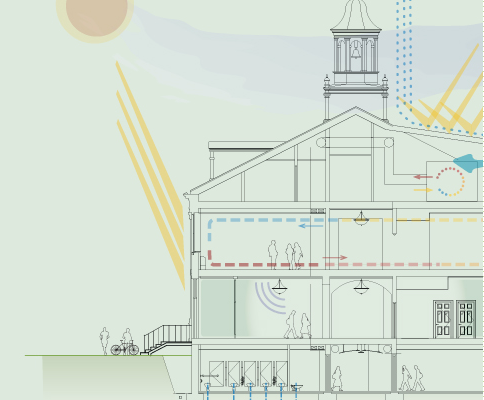Lessons of Green Schools

Learn about the implementation of green strategies at Shady Side Academy | Rowe Hall. Click image for more.
With over 60 million students and faculty and as parts of our communities, school environments engage over 20% of the US population. It stands to reason that if we can green America’s schools, we can greatly improve the current status of our built and natural environments. But perhaps the best indicator of the success of a school is not immediately apparent as we lay the foundations of hope for the future. Winston Churchill said, “We shape our buildings and then they shape us.” Green schools can help shape a community where we can be better stewards of our environment, deal wisely with issues of social equity and meet the realities of economics.
Green schools can be examined by their building performance, which leads to decreased costs for energy, operations, and maintenance. Green schools also promote human performance by creating better quality environment in which to learn and work. Green schools can also be approached as a pedagogical tool, where the design, materials, and operations of the building are integrated into the academic and community life to make better citizens and build our communities. Green schools will be a high priority for economic viability in the public sector and for national security.The US Green Building Council decided in 2002 that K-12 schools are a specific building type more critical than other environments. We agree with this thinking. If indices of materials safety in the US are commonly calibrated to healthy 30 year old males, what does this mean to an eight year old child or a kindergartener? The LEED for Schools Rating System has emerged as a best practices document and, as of April 2007, is mandatory for the LEED certification of any K-12 schools. With LEEED 2009 now, LEED for Schools is not a distinct rating system, but its requirements are explicitly stated, maintaining the specific requirements for exemplary greening of K-12 schools.
Some Benefits of Green Schools
Healthy Interiors
Children’s rapid growth cycles make them especially vulnerable to indoor pollutants. Studies show repeated exposure to VOC’s and other chemicals can cause adversarial effects on health and behavior.
Quiet Acoustics
Noisy environments may be annoying and distracting to us, but for children the effect is magnified. Care must be given to create appropriate environments that are conducive to focus and concentration.
Return on Investment
![]() Schools are social institutions. Investing in their long term value will yield financial benefits for decades beyond recapture of the initial investment.
Schools are social institutions. Investing in their long term value will yield financial benefits for decades beyond recapture of the initial investment.
Daylight in Classrooms
![]()
Daylight and views both reassure and calm us. Well rendered lighting coming from more than one direction enables greater concentration and less eye strain. Studies show significant improvement in test scores in daylit environments.
Educational Opportunities
![]() The inclusion of green strategies in any project serves double duty — the direct benefit and the opportunity for outreach. This is especially so in schools, where any strategy, especially the visible ones, can be an opportunity to teach concepts across content areas.
The inclusion of green strategies in any project serves double duty — the direct benefit and the opportunity for outreach. This is especially so in schools, where any strategy, especially the visible ones, can be an opportunity to teach concepts across content areas.
Financial Reimbursements
![]() Pennsylvania has financial incentives for the achievement of LEED certification for schools. We have found that reimbursements can offset all LEED-related costs.
Pennsylvania has financial incentives for the achievement of LEED certification for schools. We have found that reimbursements can offset all LEED-related costs.


![Download Green Schools Poster [PDF]](https://evolveea.com/wp-content/uploads/2011/01/greenschoolsposter1.gif)